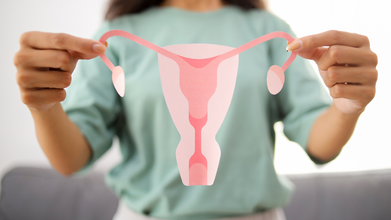- Health Conditions A-Z
- Health & Wellness
- Nutrition
- Fitness
- Health News
- Ayurveda
- Videos
- Medicine A-Z
- Parenting
- Web Stories
Nearly 70% of U.S. Adults Now ‘Obese’ Under New Health Definition

Credits: Canva
According to the National Institutes of Health (NIH), US, approximately 42.4% of US adults have obesity. However, this number can increase further as a recent study suggests a new definition of what might be considered as obese. As per the new definition, almost 70% of US adults will be considered obese.
The research is published in the journal Jama Network Open by Dr Lindsay Fourman, the first author of the study, from Mass General Brigham in the US.
What has changed?
The traditional definition of obesity was based on having a body mass index or BMI of 30 or greater, which has been contentious. This is also because it fails to differentiate between fat and muscles.
To address the growing obesity crisis, medical experts worldwide proposed a new definition earlier this year. The revised criteria would include people with a BMI over 40, or those with elevated readings for waist size, waist-to-hip, or waist-to-height ratio—either alongside a high BMI or in multiple raised measures, regardless of BMI.
Another change brought in was to categorize obesity into two:
1. Clinical obesity, where there are signs of illness
2. Pre-clinical obesity, where there are no signs of illness
As per this revamped definition, notes Fourman, there has been increase in obesity prevalence in the US. It means people who were earlier not considered obese as per their BMI, will not fall under this category.
What The Expert Explains
“Recognizing people with [this type of] obesity can lead to more accurate health risk stratification,” she said. “For example, someone with BMI 23 but excess abdominal fat could benefit from lifestyle interventions such as improving diet and increasing physical activity, even though their BMI is in the “normal” range. Their physician might also more closely monitor for obesity-related complications such as pre-diabetes or fatty liver.”
How Was The Study Conducted?
The researchers applied both the traditional and newly proposed definitions of obesity to data from 301,026 U.S. adults aged 18 to 80, who participated in a national health study between May 2017 and September 2023.
Using the standard BMI data, 43%, which means 128,992 participants were now classified obese. However, as per the new definition, it has gone up to 65%, making it 206,361 participants. It is a nearly 60% jump. Among adults aged 70 and older, the obesity prevalence is at 78%.
Almost everyone identified as obese by the traditional BMI measure also met the new criteria, with only 678 individuals no longer classified as such. Notably, the updated definition captured an additional 78,047 participants who would not have been considered obese under BMI alone.
“Our data show that these individuals have a heightened risk of organ dysfunction and long-term health complications, suggesting that their classification as having obesity is clinically appropriate,” said Fourman.
Of those who were now defined obese without a high BMI, 48% had clinical obesity. 56% of them were those who had obesity based on their BMI together with other measures.
Ozempic And Wegovy Users Are Reporting A Growing ‘Unusual’ Side Effect, Study Finds

Credits: Canva
A recently published study has drawn attention to a new and rather unexpected side effect linked to popular weight-loss medications.
Drugs such as Ozempic and Wegovy, originally developed for type 2 diabetes but now widely used for weight management, have seen a sharp rise in demand. A Kaiser Family Foundation survey released in May 2024 found that roughly one in eight American adults has used a GLP-1 drug.
However, as their use becomes more widespread, doctors are identifying additional side effects, one of which may complicate the results of certain medical scans.
Ozempic And Wegovy Users Are Reporting A Growing ‘Unusual’ Side Effect
Researchers at Alliance Medical, a European imaging services company, examined PET-CT scans of cancer patients who were using GLP-1 medications. In this type of scan, a patient is given an intravenous injection of a radioactive sugar compound called fluorodeoxyglucose (FDG). Because diseased cells consume more of the substance than healthy ones, the PET scanner highlights these areas as “hot spots,” as described by the Cleveland Clinic.
Often, PET and CT scans are done together, the CT providing X-ray–based images that, when combined with PET data, give doctors a detailed 3D view of the body.
According to findings presented in September at the Annual Congress of the European Association of Nuclear Medicine, Alliance Medical researchers observed several abnormal FDG uptake patterns among patients using GLP-1 drugs. These irregularities could easily be mistaken for signs of disease if physicians are unaware of the patient’s medication use.
“We first saw an unexpected uptake pattern in one patient taking a GLP-1 agonist, which led us to conduct a broader review across our centers,” said Dr. Peter Strouhal, Medical Director at Alliance Medical, in a statement shared by the American Association for the Advancement of Science.
If these scans are read incorrectly, patients could face unnecessary diagnostic procedures, inaccurate cancer staging, and potential delays in receiving the right treatment.
Other Side Effects Of Weight Loss Drugs
Many people who use GLP-1 medications experience digestive discomfort such as nausea, vomiting, constipation, diarrhea, or heartburn. The drugs are also known to carry risks like gallbladder disease, bone fractures, and, in some cases, pancreatitis.
Recently, however, new physical changes popularly referred to as “Ozempic vulva” and “Ozempic breasts” have begun drawing attention. Across social media, women have described noticeable changes since starting these injections, including sagging skin, vaginal dryness, weakened pelvic muscles, and occasionally an increase in discharge.
Though vaginal changes are not listed among the official side effects of GLP-1 drugs, specialists believe they may be connected to the rapid fat loss these medications cause. As body fat decreases, the natural fat pads that cushion and support vulvar tissue can diminish, leading to visible and functional changes.
“Ozempic breasts” is a term used to describe changes in breast size or shape that occur after significant weight loss from GLP-1 medications such as Ozempic and Wegovy. Many women report reduced volume, increased sagging, and, in some cases, tenderness as their body fat percentage drops.
THIS Common Hormone Condition Is The Most Misdiagnosed In Women

Credits: Canva
Scrolling through social media, many women encounter stories of celebrities describing years of unexplained symptoms before receiving a diagnosis of polycystic ovary syndrome (PCOS). Model and actress Lori Harvey recently shared her experience with weight fluctuations, acne, facial hair growth, and painful irregular periods, highlighting a common struggle among women of reproductive age. Stories like hers resonate with women like Alexis King, who found validation in hearing someone else’s journey, as reported in Washington Post.
PCOS is a hormone disorder affecting roughly one in ten women worldwide, including about six million Americans. It is linked to both reproductive and metabolic dysfunction, increasing the risk of fertility problems as well as chronic conditions such as high blood pressure, diabetes, obesity, and cardiovascular disease. Despite its prevalence, PCOS remains underfunded and under-recognized, leaving many women to navigate the condition largely on their own.
A “Silent” Diagnosis
For many, PCOS is identified only after years of unexplained symptoms. Patients often encounter healthcare providers who focus on cosmetic solutions rather than addressing the underlying hormonal imbalance. Researchers note that PCOS is considered an “orphan disorder” in women’s health, receiving significantly less funding than conditions with comparable prevalence and severity. From 2016 to 2022, average annual funding for PCOS was around $32 million, compared with $262 million for rheumatoid arthritis and $66 million for tuberculosis, according to recent studies reported in Washington Post.
Experts stress the need for comprehensive management rather than relying on individual supplements, though some, such as inositol, have shown promise in improving metabolic and reproductive outcomes. There is no cure or FDA-approved treatment specifically for PCOS, though existing interventions can alleviate symptoms and reduce long-term health risks, according to Richard Legro, chair of obstetrics and gynecology at Penn State Health Milton S. Hershey Medical Center, as reported in Washington Post.
Challenges in Diagnosis
A full PCOS diagnosis requires meeting at least two of three criteria: irregular periods, elevated male hormones, or ovaries with fluid-filled sacs visible on ultrasound. Yet many patients never undergo complete hormone testing or imaging, leaving the disorder undiagnosed for years. Clinicians often lack training to treat PCOS effectively, as it spans multiple specialties, from reproductive endocrinology to general gynecology. Multidisciplinary clinics exist but are limited in number, forcing patients to seek care from providers unfamiliar with the full scope of the disorder, as reported in Washington Post.
Delayed diagnosis can have serious consequences. Women with PCOS face increased risks of infertility, pregnancy complications, and chronic conditions. Endometrial cancer risk is higher due to irregular shedding of the uterine lining, and Black women experience disproportionately higher rates of adverse outcomes due to later diagnosis and barriers to care.
Research and Emerging Treatments
In the absence of robust funding, clinicians have relied on medications such as metformin, which improves insulin sensitivity, to manage PCOS symptoms. Research is also exploring the use of weight-loss drugs, such as semaglutide, to regulate hormone levels, restore periods, and reduce metabolic risks. Early trials show promise, with participants reporting restored menstrual cycles, improved hormone balance, and weight loss, as reported in Washington Post.
Despite these advances, insurance coverage remains a challenge. Patients often must pay out of pocket for medications that are not yet FDA-approved specifically for PCOS. Researchers like Melanie Cree, a pediatric endocrinologist, are pushing for standardized testing and more clinical trials, but funding delays and reduced philanthropic support continue to slow progress.
As awareness grows, advocates and researchers aim to prioritize PCOS as a significant public health concern, emphasizing early detection, comprehensive treatment, and equitable access to care. For millions of women, improved understanding and treatment of PCOS could transform lives, reducing both immediate discomfort and long-term health risks, as reported in Washington Post.
NHS Approves Injection That Could Stop HIV

Credits: Canva
For the first time, patients in England and Wales will be able to access a long-acting injection to prevent HIV through the NHS, bringing the policy in line with Scotland. The new jab, administered every two months, provides an alternative to daily oral pills, offering convenience and discretion for those who find tablets challenging to take.
Experts hope the introduction of cabotegravir (CAB-LA) injections will help the UK meet its goal of eliminating new HIV cases by 2030. Meanwhile, early results from another injection, lenacapavir, suggest that annual HIV prevention injections could become a possibility in the future.
A “Game-Changing” Option
Wes Streeting, the Secretary of State for Health and Social Care, described the new injection as “game-changing” and told the BBC: “For vulnerable people who are unable to take other methods of HIV prevention, this represents hope”.
HIV prevention therapy, known as PrEP (pre-exposure prophylaxis), is used by HIV-negative individuals to reduce the risk of infection. While daily oral PrEP has been effective for years, some people find it difficult to adhere to. Challenges include lack of privacy, homelessness, domestic violence, or the fear of others discovering their medication.
A long-acting injection that lasts for months addresses these issues, offering both practicality and discretion. Cabotegravir, produced by ViiV Healthcare, is intended to be used alongside safer sex practices, such as condom use. NHS England has secured a confidential discount from the manufacturer, whose list price is around £7,000 per patient per year, as reported by the BBC.
Who Will Be Eligible?
The injection will be offered to adults and adolescents at high risk of sexually acquired HIV who are eligible for PrEP but may struggle with daily tablets. Around 1,000 people are expected to be offered the injection initially, with others continuing or starting oral PrEP. Patients can access it through NHS-operated sexual health clinics “in the coming months,” according to the National Institute for Health and Care Excellence (NICE).
Dom Baldwin, who currently takes PrEP pills, told the BBC he is “over the moon” about the injections: “When you look at where we are now compared to the epidemic in the 80s… HIV is no longer a death sentence”.
Calls for Rapid and Equitable Rollout
Charities have emphasized the need for a fast rollout, as some patients face long waits for appointments. Richard Angell, of the Terrence Higgins Trust, said to the BBC that the therapy should be offered in more settings, not just sexual health clinics: “It’s highly effective and acceptable for patients, and a vital tool for tackling inequalities, with the potential to reach those who are not currently accessing other HIV prevention”.
Official figures show that PrEP access in England is increasing, but gaps remain. In 2024, 146,098 HIV-negative people attending sexual health services were at substantial risk of HIV, with about 76% starting or continuing PrEP, a 7.7% rise from 2023. However, uptake varies by group, with lower rates among black African heterosexual men and women compared to men who have sex with men.
Dr Michael Brady, NHS England’s National Advisor for LGBT+ Health, said to the BBC: “This long-acting injection is a significant addition to our HIV prevention strategies, giving us a powerful new option for people at risk of HIV who cannot have oral PrEP tablets”.
© 2024 Bennett, Coleman & Company Limited

